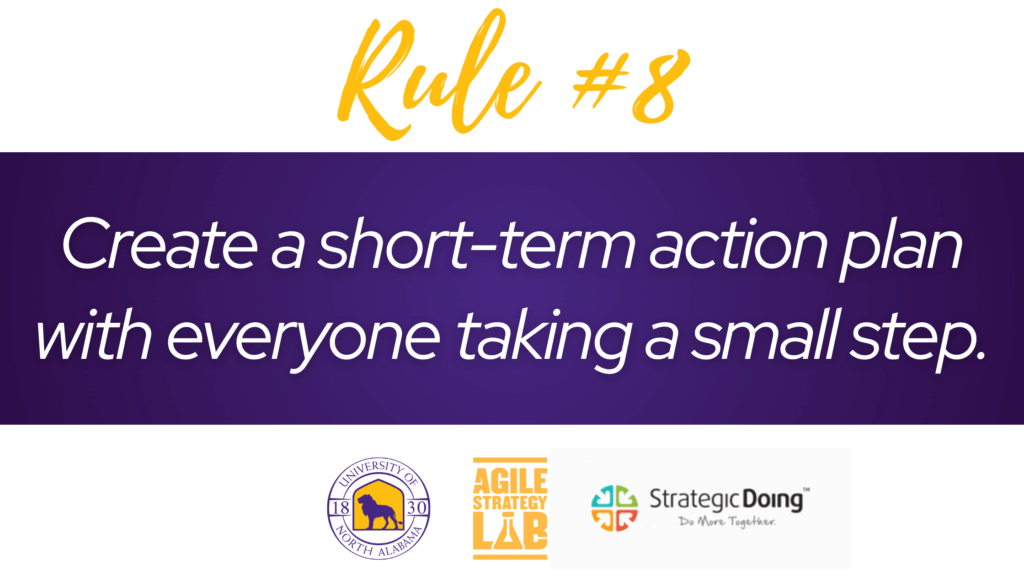…And…action! – Rule/ Skill #8
This is post #11 of our 14 week series on the 10 Questions and 4 Rules of Strategic Doing. (Start with the first post.)


In writing this post on the 8th rule/skill of Strategic Doing/agile leadership, a phrase kept coming to mind: “man of action.” My first question was why we don’t say a “woman of action” – and a quick online query gave me the answer: the phrase is mostly associated with three old films – none later than 1933. Of course there were women of action then as well – it’s just that (apparently) no one was making movies about them. But what does it mean to be a man or woman of action now?
If you’ve been following along with these posts, you may be thinking “Finally…”, (although during a Strategic Doing workshop, it’s only about 2 hours into the process) it’s time to say “and…action.” Specifically, building an initial action plan. If you’re a person that loves checking off tasks, you’ll love this one. If the thought of that fills you with anxiety, this might be more difficult. Either way, it’s what moves a conversation from an interesting exchange of ideas to something that will really happen.
Intrigued by the idea of getting your group from framing the issue to action in two hours? We’d love to help you.
Why this rule is important
Most people are tired of meetings that never get beyond talk to action. But we do a lot of that – we spend almost a third of our work time in meetings. The number of meetings we have has tripled in just the last 5 years (thank you, remote work and Zoom). One study found that more than half of us would deem our last meeting one where little was accomplished. There’s even something called “meeting recovery syndrome” (read these and more facts about meetings here).
It’s not just the wasted time that matters. The most valuable asset your team has is its commitment to solving the issue at hand. Once that commitment fades, it’s hard – if not impossible – to get it back. And nothing drains it faster than a growing sense that the effort won’t lead anywhere.
How to create your action plan
Use a chart. There’s something about a chart that motivates a group to not leave it unfinished. The chart should have 4 columns: who is committing to take action, what – specifically – they’re committing to do, a deliverable or artifact from doing it, and a date it will be done.
Keep it small. We use the idea of micro-commitments: no one signs up for something that will take too much time. For new teams, we recommend no more than one hour in the next 30 days (or whatever interval you have between meetings).
Forget “everyone.” Don’t put “everyone” in that first column – ever. No task should have more than two people accountable for it. It’s fine for others to have an input or reviewing role – but when you say everyone will do something, odds are that no one will do it.
There are no observers. The other thing that saps a team’s commitment is the sense that some people (usually senior leaders) don’t have to do anything. Everyone should be on that chart (remember, micro-commitments: it doesn’t have to be very big at all). Make exceptions only for life or career-changing events: welcoming a new child, chairing a national conference, etc.
What’s next?
Action step: just do it. At your next meeting, draw a grid: 4 columns, one line for each person in the room. Ask each person in the room to volunteer to do something small before the next meeting to move the work forward, and fill in that chart. You may get looks of shock the first time, but people will leave saying (often in surprise), “we got something done!”
Learn more: micro-commitments work in your personal life as well. Get some tips that work in almost any context.
You’ve made it to the final Question.

Liz shepherds the expansion of the Lab’s programming and partnerships with other universities interested in deploying agile strategy tools. A co-author of Strategic Doing: 10 Skills for Agile Leadership, she also focuses on the development and growth of innovation and STEM education ecosystems, new tool development, and teaching Strategic Doing.
